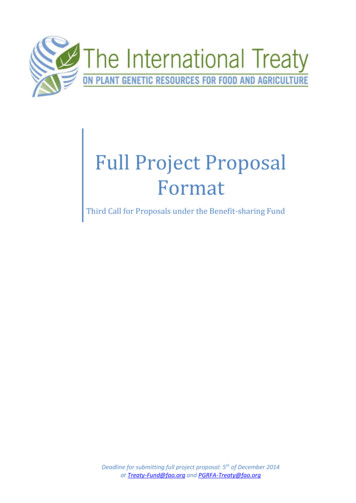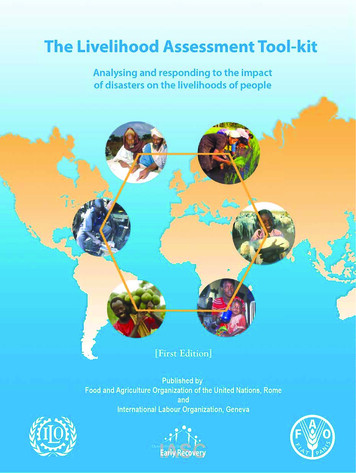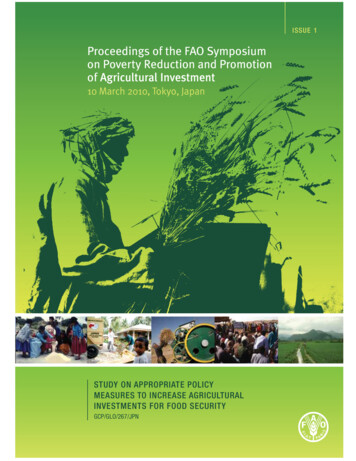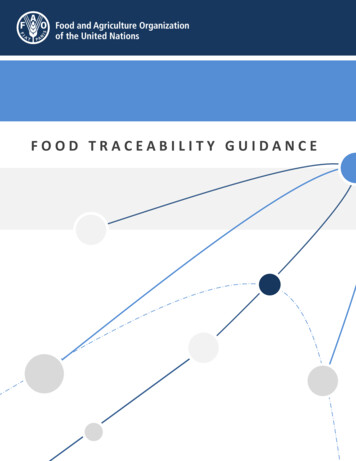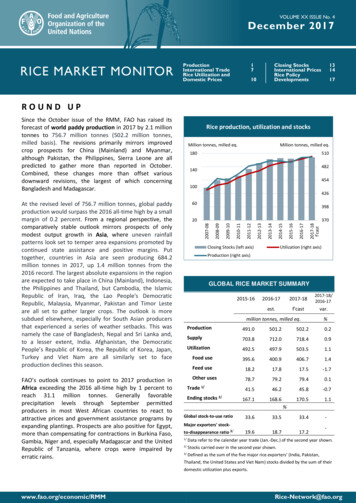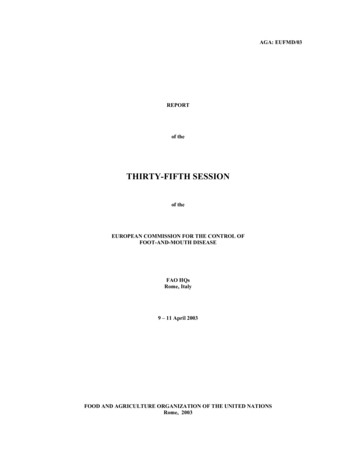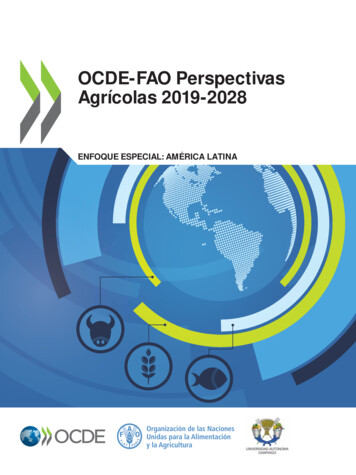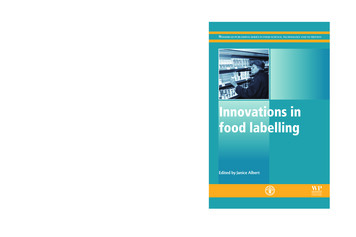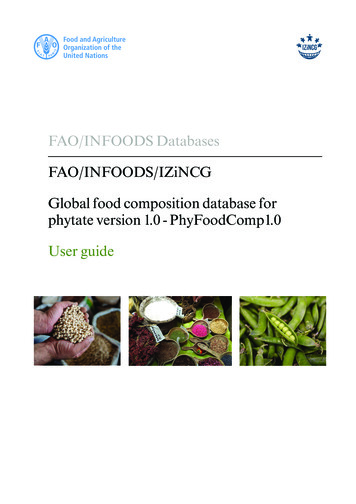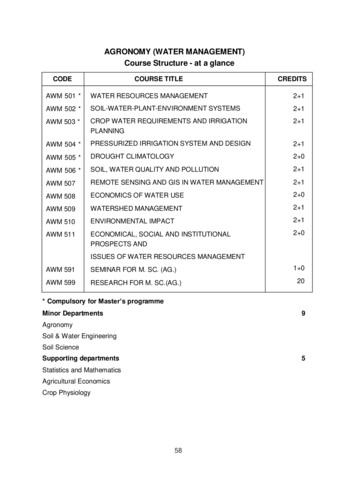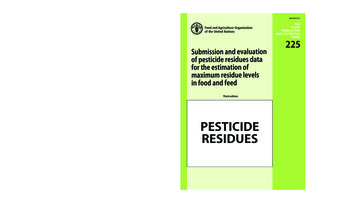
Transcription
ISSN 0259-2517225FAOPLANTPRODUCTIONAND PROTECTIONPAPERISBN 978-92-5-10913-37 8 9 2 5 1ISSN 0259-25170 9 1 3 3 3I5452E/1/03.16FAO9Submission and evaluation of pesticide residues data for estimation of maximum residue levels in food and feedThe first version of this manual on the submission and evaluation of pesticide residues data forestimation of maximum residue levels in food and feed was printed by FAO in 1997 as a workingdocument with the aim of consolidating the procedures used by the FAO Panel of experts onpesticide residues. The FAO Manual was revised in 2002 and in 2009 incorporated additionalinformation from the JMPR Report of 1997-2009. Since then there have been many developments inthe scientific evaluation process of the Joint Meeting on Pesticide Residues (JMPR), administered byFAO and the World Health Organization. The present manual incorporates all relevant informationand principles that are currently used by the JMPR to estimate maximum residue levels (MRLs),supervised trials median residue (STMR) values and dietary risk from pesticide residues. The manualwill constantly be revised and updated in the light of experience gained and developments inresidue data evaluation. Its aim is also to improve communication between the Codex Committeeon Pesticide Residues (CCPR) and its member countries and other participants in the CCPR and toexplain the procedures being adopted by the FAO Panel of the JMPR.Submission and evaluationof pesticide residues datafor the estimation ofmaximum residue levelsin food and feedThird editionPESTICIDERESIDUES225
Front Grey Page Manual 2015 copy.pdf 1 22/01/2016 12:12:53Submission and evaluationof pesticide residues datafor the estimation ofmaximum residue levelsin food and feedThird editionCMYCMMYCYCMYKFOOD AND AGRICULTURE ORGANIZATION OF THE UNITED NATIONSRome, 2016FAOPLANTPRODUCTIONAND PROTECTIONPAPER225
The designations employed and the presentation of material in this information product do not imply theexpression of any opinion whatsoever on the part of the Food and Agriculture Organization of the UnitedNations (FAO) concerning the legal or development status of any country, territory, city or area or of itsauthorities, or concerning the delimitation of its frontiers or boundaries. The mention of specific companiesor products of manufacturers, whether or not these have been patented, does not imply that these havebeen endorsed or recommended by FAO in preference to others of a similar nature that are notmentioned.The views expressed in this information product are those of the author(s) and do not necessarily reflect theviews or policies of FAO.ISBN 978-92-5-109133-3 FAO, 2016FAO encourages the use, reproduction and dissemination of material in this information product. Exceptwhere otherwise indicated, material may be copied, downloaded and printed for private study, research andteaching purposes, or for use in non-commercial products or services, provided that appropriateacknowledgement of FAO as the source and copyright holder is given and that FAO’s endorsement ofusers’ views, products or services is not implied in any way.All requests for translation and adaptation rights, and for resale and other commercial use rights should bemade via www.fao.org/contact-us/licence-request or addressed to copyright@fao.org.FAO information products are available on the FAO website (www.fao.org/publications) and can bepurchased through publications-sales@fao.org.
FAO Manual on the Submission and Evaluation of Pesticide Residues DataPREFACEThe basic principle of the work undertaken by members of the Joint FAO/WHO Meeting onPesticide Residues (JMPR), is the continuous evaluation of new scientific developments andguidance documents. In considering such initiatives, the members draw on their ownexperience to elaborate and apply new principles and approaches in the assessment of data.The aim being to make best use of all available information when making recommendationsto the Codex Committee on Pesticide Residues (CCPR) and Codex Members in order toensure consumer safety and facilitate international trade.The 3rd edition of the FAO Manual incorporates the current working principles applied by theFAO Panel for evaluation of pesticide residues to recommend maximum residue levels,STMR and HR values and to assess the dietary exposure of consumers.In addition to the general updating of the text, the third edition contains new information onthe:x incorporation of the ‘Risk analysis principles applied by the CCPR’ in the workingprocedures of the JMPR;x method validation and performance criteria of analytical methods applied in supervisedtrials, including sample preparation and processing, and considering residues belowLOQ;x risk assessment of metabolites and degradates of pesticides by applying the thresholdtoxicological concern, TTC, approach;x principles of grouping crops for recommending residue levels for commodity groups;x use of proportionality of residues for adjusting residue values to match cGAP;x application of the concept of ‘Global GAP’;x estimation of maximum residue levels based on the results obtained with the OECDMRL calculator;x refined procedures for estimation EMRL and residue levels for spices;x application of the GEMS/Food 17 cluster diet for estimation of long-term dietary intakeof pesticide residues;The reporting of supervised trials are assisted with the attached electronic versions of theExcel templates and spreadsheets to the Manual that can be downloaded from the FAOHomepage map/theme/pests/jmpr/jmpr-docs/en/The JMPR will continue its activities with respect to considering and refining assessmentmethodologies to ensure the best use is made of all available information. Wheremodifications to current practices are deemed warranted, the basis for such changes will beelaborated in the annual JMPR Reports. The reader is advised to consult the Reports forinformation on any such new developments. heme/pests/jmpr/jmpr-rep/en/).iii
FAO Manual on the Submission and Evaluation of Pesticide Residues DataACKNOWLEDGEMENTProfessor Árpád Ambrus, a FAO temporary advisor, prepared the manuscript for the thirdedition.During past years the Members of the FAO Panels took active part in the elaboration of theworking principles, which are included in this and the previous editions.Mrs. Trijntje van der Velde-Koerts proposed substantial structural changes of the 3rd editionof the Manual to improve usability and facilitate the finding of relevant information. ProfessorEloisa Dutra Caldas, Mr. Makato Irie, Dr. Dugald MacLachlan, Dr. Mi-Gyung Lee, Mr.David Lunn, Dr Samuel Margerison, Mr. Christian Sieke, Dr Anita Strömberg, Dr.YukikoYamada, and Dr Guibiao Ye provided additional suggestions for improving the clarity andrelevance of the text. Dr Mi-Gyung Lee prepared Annex 2 of Appendix X. Mr. ChristianSieke provided the Excel template for calculation of animal burdenDr Yong Zhen Yang, FAO Joint Secretary, contributed with useful comments and suggestionsto the preparation of the manuscript. All contribution and assistance are sincerely appreciated.Mr. Kevin Bodnaruk, FAO Editor, assisted with the editing of the text and with the style ofthe Manual layout.iv
FAO Manual on the Submission and Evaluation of Pesticide Residues APTER 1INTRODUCTION1.1 Scope of this manual1.2 Historical background1.3 The object of the work of JMPR1.4 The JMPR assessment process1.5 Data and information required for JMPR evaluations1.5.1 New and periodic reviews1.5.1.1 New and existing MRLs1.5.1.2 GAP information.1.5.1.3 Supporting studies.1.5.2 Re-evaluations111134668999CHAPTER 2PREPARATION OF DATA DOSSIERS FOR THE CONSIDERATION OF THE FAO PANEL OFJMPR2.1 Organization of the dossier2.2 Data directory2.3 Working paper2.3.1 Utilisation of national evaluations1111121314CHAPTER 3JMPR EVALUATIONS – REQUIREMENTS AND PRACTICES3.1 Introduction3.2 Identity and physical chemical properties3.2.1 Identity3.2.2 Physical and chemical properties3.3 Metabolism and environmental fate3.3.1 Plant metabolism3.3.2 Rotational crop studies3.3.3 Farm animal metabolism3.3.4 Environmental fate in soil, water and water-sediment systems3.4 Residue analysis3.4.1 Analytical methods3.4.2 Extraction efficiency of residue analytical methods3.4.3 Stability of pesticide residues in stored analytical samples3.5 Use pattern3.5.1 Periodic review compounds undergoing re-registration by national authorities3.5.2 Presentation of GAP information3.6 Residues resulting from supervised trials on crops3.6.1 Planning and implementation of supervised trials3.6.1.1 Number of trials3.6.1.2 Consideration of various types of formulations and derivatives of active ingredient3.6.2 Sampling and analytical methods3.6.3 Reporting the results of trials3.7 Fate of residues in storage and processing3.7.1 Information and data from trials on stored products3.7.2 Fate of residues in food processing3.7.2.1 Guidelines for the conduct of processing studies on the nature of the 48495051515255v11
FAO Manual on the Submission and Evaluation of Pesticide Residues Data3.7.2.2 Test conditions for processing procedures3.8 Residues in animal commodities3.8.1 Animal feeding study3.8.2 Documentation of animal feeding studies3.8.2.1 Nature of fat samples in studies with fat-soluble compounds3.8.3 Direct treatment of animals or premises3.9 Residues in food in commerce and at consumption3.9.1 Data requirements for EMRL estimation3.9.2 Submission of information for estimation of MRLs of pesticide residues in/on spices3.9.2.1 Submission of monitoring data3.9.2.2 Designing of selective field surveys and reporting data for obtaining residue data in/onspices3.10 National residue definitionsCHAPTER 4DEFINITION OF RESIDUES4.1 Definition of residues4.1.1 General principles4.1.2 Dietary risk assessment of metabolites and degradates of pesticides4.1.3 Principles followed in defining residues for enforcement4.2 Fat APTER 581JMPR PRACTICES IN ESTIMATION OF MAXIMUM RESIDUE LEVELS, AND RESIDUESLEVELS FOR CALCULATION OF DIETARY INTAKE OF PESTICIDE RESIDUES815.1 Introduction815.2 Comparability of supervised trial conditions to GAP825.2.1 General principles825.2.2 Application rate835.2.3 Pre-harvest interval845.2.4 Number of treatments865.2.5 Formulation865.2.6 Interpretation tables for supervised trials data875.3 Definition of independent supervised residue trials875.4 Selection and reporting of residue data885.4.1Treatment of apparent outliers895.4.2 Residues below LOQ895.4.3 Rounding of residue values895.5 Combining of data populations895.5.1 Estimation of group maximum residue levels STMR and HR values for plant commodities 905.5.2 Combining residue data from supervised trials conducted in different locations955.6 Estimation of maximum residue levels in plant commodities965.6.1 Information considered in estimating maximum residue levels965.6.2 Principles of selection of residue data for estimation of MRLs985.7 Specific considerations in estimating maximum residue levels for individual commodities995.7.1 Fruits and vegetables995.7.2 Grains and seeds995.7.3 Forage and fodder995.8 Extrapolation of residue data to minor crops1005.9 Statistical methods for estimation of MRLs for plant commodities based on supervised trial data1015.10 Processed commodities1025.10.1 General principles1025.10.2 Special considerations for dried chili peppers1035.11 Estimation of maximum residue levels based on monitoring data1035.11.1 Estimation of maximum residue levels, HR and STMR values in spices1035.11.2 Estimation of extraneous maximum residue levels1055.12 Estimation of maximum residue levels, STMR and HR values for commodities of animal origin1065.12.1 Residues arising from consumption of feed items107vi
FAO Manual on the Submission and Evaluation of Pesticide Residues Data5.12.1.1 Use of the calculated dietary burdens to estimate maximum residue levels, and STMR andHR values for commodities of animal origin1125.12.2 Residues arising from direct application to farm animals1145.12.3 Reconciliation of MRL recommendations resulting from direct treatment and from residues inanimal feed1145.12.4 Maximum Residues in Animal products1145.13 Expression of maximum residue limits (MRLs)1175.13.1 Expression of MRLs at or about the LOQ1185.14 Recommendations for maximum residue limits1215.14.1 Recommendation of temporary MRLs1215.14.2 Guideline Levels121CHAPTER 6ESTIMATING DIETARY INTAKE OF PESTICIDE RESIDUES6.1 Background6.2 Long-term dietary intake6.3 Short-term dietary intake6.4 Acute reference dose6.5 IESTI tables6.5.1 Animal commodities IESTI calculations6.6 Handling of cases where JMPR estimates of dietary intake exceed the ADI or ARfD123123123124127129130132132CHAPTER 7USE OF JMPR RECOMMENDATIONS BY REGULATORY AUTHORITIES7.1 Introduction7.2 Safety assessment of pesticides7.2.1 Relevance of pesticide specifications for JMPR evaluations7.3 Residue studies and recommended MRLs7.4 Interpretation of residue analytical results in comparison with MRLsREFERENCES135135135135136136137141Appendix IABBREVIATIONS USED IN THE TEXT147147Appendix IIGLOSSARY OF TERMS149149Appendix IIISTANDARD TWO LETTERS CODE FOR PESTICIDE FORMULATIONS157157Appendix IVMRL PERIODIC REVIEW PROCEDURE BY CCPR159159Appendix VRECOMMENDED SAMPLING METHODS FOR SUPERVISED FIELD TRIALS1. General recommendations2. Contamination3. Control samples4. Sampling in decline studies and at normal harvest time5. Sampling animal tissues, milk and eggs6. Sampling processed commodities7. Sampling stored commodities8. Sample size reduction9. Sample packing and storage165165165166167167172174174175175Appendix VI179PORTION OF COMMODITIES TO WHICH CODEX MAXIMUM RESIDUE LIMITS APPLY AND179WHICH IS ANALYSED22Appendix VII187
FAO Manual on the Submission and Evaluation of Pesticide Residues DataSTANDARDIZED FORMAT FOR ORGANIZING THE DATA DIRECTORY (INDEX) OFINFORMATION TO BE SUBMITTED FOR EVALUATION187Appendix VIIIPESTICIDE INFORMATION FOR CCPR WORKING GROUP ON PRIORITIESa191191Appendix IXMAXIMUM PROPORTION OF AGRICULTURAL COMMODITIES IN ANIMAL FEEDTable IX.1 Beef and dairy cattleTable IX. 2 Percent of poultry dietTable IX. 3 Percent of sheep diet193193193196200Appendix XJMPR MANUAL FOR FAO PANEL MEMBERS1. Introduction2. General3. Format3.1 Tables3.2 Diagrams4. JMPR reports5. Duties of the FAO panel chairperson and rapporteur6. Actions before the meeting7. A residue evaluation (draft monograph)8. Draft appraisal213213213213215215218218219219220237Annex 1 of Appendix X246List of all countries with their 2 digit codes (ISO 3166-2)Annex 2 of Appendix X246249Classification for the fruit commodity groups including examples of the selection of representativecommodities (adopted by CAC in 2012)249Annex 3 of Appendix X256Test conditions for brewing and processing tea1. Procedure for brewing tea in China2. Procedure for brewing tea in Japan3. Test Guideline for Pesticide Residues in Green Tea256256256256Appendix XI261TABLE AND SPREADSHEET EXAMPLES261Table XI.1. Residue interpretation table for folpet residues on tomatoes.262Table XI.2. Summary of good agricultural practices for pesticide uses.263Table XI.3. Residues data summary from supervised trials264Table XI.4. Example Table format for long-term dietary intake calculation.266Table XI.5. Table format for long-term dietary intake calculation (myclobutanil example).267Table XI.6 Table format for IESTI calculation for general population (example)268Appendix XII269NUMBER OF TRIALS REQUIRED BY OECD MEMBER COUNTRIES269Table XII.1. Example for calculation of minimum number of trials depending on the crop productionregions269Table XII.2 Minimum number of Supervised Field Trials Required at cGAP for Field (or Outdoor) Uses271Appendix XIIIPRINCIPLES OF THE MANN-WHINEY AND KRUSKAL WALLIS TESTS1 The Mann-Whitney U-test2. Kruskal-Wallis H-testCRITICAL VALUES FOR MANN-WHITNEY U-TEST AT Α2 0.05viii277277277278281
FAO Manual on the Submission and Evaluation of Pesticide Residues DataAppendix XIVELECTRONIC ATTACHMENTS1XIV.1 Annex to Appendix VII. Template for summarising supervised residue trials data.xlsxXIV.2 Guidance IESTI 2014.pdfXIV.3. IESTI calculation15model final.xlsxXIV.4. IESTI data overview.xlsxXIV.5. IEDI calculation02 17 cluster diet.xlsxXIV.6 OECD MRL calculator multiple.xlsxXIV.7 OECD MRL calculator single compound.xlsxXIV.8 OECD MRL Calculator White paper.pdfXIV.9 OECD MRL Calculator User Guide.pdfXIV.10 OECD feed calculatorV1 5.xlsxXIV.11 Kruskal Wallis test explanationXIV.12 Kruskal Wallis calculation 282SUBJECT INDEX283
Chapter 1 – IntroductionCHAPTER 1INTRODUCTIONCONTENTSScope of this ManualHistorical backgroundThe object of the work of the JMPRThe JMPR assessment process1.1 Scope of this manualThe Manual gives the historical background of the operation of the JMPR and describes thepurpose of the work, the procedures involved in selection of compounds, the datarequirements for estimating maximum residue levels and the principles followed in theevaluation of experimental results and information provided.The definition of terms used in this Manual is given in Appendix II. The documents whichwere used in the preparation of the Manual are listed under “References.”1.2 Historical backgroundThe rapidly growing use of pesticides in agriculture after World War II gave rise to regulationby governments of the sale and use of pesticides to prevent chemicals with unacceptableproperties being introduced onto the market. The use of chemicals was regulated in order toprotect the users of pesticides, the consumers of treated foodstuffs, domestic animals and, at alater stage, the environment.For this purpose, governments requested manufacturers and other data submitters to submitinformation on the properties of their products and on their intended uses. As differencesarose among countries on the extent and scope of data to be supplied, internationalorganizations initiated attempts to harmonize requirements.In April 1959, the Director-General of FAO convened a Panel of Experts on the Use ofPesticides in Agriculture. The meeting was held in Rome. This panel considered variousproblems connected with the use of pesticides. With regard to pesticide residues the panelconcluded that governments should be urged to include, in addition to public healthauthorities, bodies involved in agricultural pesticide and plant and animal protection whichadvise on regulations to control pesticide residue levels. Studies should be intensified onproblems involving the analysis of pesticide residues in or on foodstuffs. Furthermore, thepanel recommended studies to be undertaken jointly by FAO and WHO on the hazards arisingfrom pesticide residues in and on food and feedstuffs, on the establishment of principlesgoverning the setting up of pesticide tolerances, on the feasibility of preparing an InternationalCode for toxicological data and residue data required to achieve the safe use of a pesticide.A joint meeting of the FAO Panel of Experts and the WHO Expert Committee on PesticideResidues was held in Rome in October 1961 to implement this recommendation. In their letterto the members of this meeting, the Directors-General of FAO and WHO stated that themeeting should consider, among other matters, principles for establishing tolerances forpesticide residues in food. The meeting developed definitions for a number of terms, which1
FAO Manual on the Submission and Evaluation of Pesticide Residues Datalaid the foundation for the current “Glossary of Terms” used by the JMPR. Although themeeting developed the concept of a “permissible level”, calculated from the Acceptable DailyIntake (ADI), the food factor and the average weight of the consumer, it accepted at the sametime that the “tolerance”, which is comparable with the present MRL, be estimated “.takinginto account the range of residues actually remaining when the food is first offered forconsumption (following Good Agricultural Practice)”. The meeting recommended to theDirectors-General of FAO and WHO the promotion of studies on methods for carrying outtoxicity studies and their evaluation, leading to ADIs and promotion of collaborative studies,leading to internationally acceptable analytical methods for pesticide residues. No conclusionwas drawn with regard to the estimation of internationally acceptable tolerances. This mightbe ascribed to the meeting’s opinion that different countries may establish different tolerancesfor the same pesticide on the same food, but that this would not impede the free movement ofthat food in international trade as long as the permissible level was not exceeded.In November 1962, an FAO Conference on Pesticides in Agriculture was held in Rome. TheConference expressed its concern that differences in residue tolerances existed not onlyamong countries of different regions but also among those of the same region. FAO wasstrongly urged to investigate the reasons for these differences and, if possible, find ways toharmonize them. Consequently, the Conference recommended that the proposed WorkingParty on Pesticide Residues should pay particular attention to (a) the toxicity of pesticides andtest methods; (b) the possible unification of tolerances; (c) coordination of methods ofanalyses; (d) surveys for collecting residue data; and (e) the establishment of a list ofpesticides to which interested governments should give research priority. The Conferencesupported the principle that the amount of pesticide residue in food should not exceed thatresulting from “Good Agricultural Practices” but recommended that governments should notadopt residue tolerances before international agreement on this subject had been achieved.In a Joint Meeting of the FAO Committee on Pesticides in Agriculture and the WHO ExpertCommittee on Pesticide Residues held in Geneva from 30 September to 7 October 1963, thetoxicological properties of a number of pesticides were studied for the first time and a fewADIs established. No developments took place in the area of residues.The first meeting of the FAO Working Party on Pesticide Residues, recommended by the1962 FAO Conference, took place in December 1963. The Working Party studied ways andmeans to arrive at recommendations for levels of residue tolerances. The following wereconsidered essential:a. Residue levels resulting from Good Agricultural Practice (GAP) should be obtainedby FAO from governments and pesticide manufacturers. These data should beconsidered by the FAO Working Party on Pesticide Residues. After considerationof the ADI and of the national nutritional patterns as stated in the FAO FoodBalance Sheets, the Working Party would propose tolerances for residues onindividual crops for consideration by governments and by the Expert Committee onPesticide Residues of the Codex Alimentarius Commissionb. Residues found in surveys of marketed commoditiesc. ADIs to be estimated by joint meetings of the WHO Committee on PesticideResidues and the FAO Committee on Pesticides in Agricultured. National nutritional patternse. Acceptable analytical methods for residues. These methods should also be adoptedby the Pesticide Committee of the Codex Alimentarius.2
Chapter 1 – IntroductionFor pesticides where an ADI had still to be estimated the Working Party would proposeprovisional tolerances. It was stated that the Expert Committee on Pesticide Residues of theCodex Alimentarius Commission (the predecessor of CCPR) should meet only after the FAOWorking Party had collected and evaluated the required data and made its proposals fortolerances. This procedure would enable the Codex Committee, composed of governmentrepresentatives, to act on the basis of technical information developed by specialists acting intheir individual capacities.1.3 The object of the work of JMPRThe JMPR is primarily responsible for performing the dietary risk assessments and proposingmaximum residue levels upon which the Codex Committee on Pesticide Residues (CCPR)and ultimately the Codex Alimentarius Commission (CAC), as well as other interested parties,base their dietary risk management decisions on Maximum Residue Limits (MRLs). JMPRproposes maximum residue levels based on residue data according to GAP/registered uses orin specific cases, such as Extraneous Maximum Residue Limit (EMRL) and MRLrecommendations for spices, based on monitoring data.The JMPR provides the CCPR and other interested parties with science-based riskassessments that include the four components of risk assessment as defined by CAC, namelyhazard identification, hazard characterisation, dietary exposure assessment and dietary riskcharacterisation that can serve as the basis for CCPR’s discussions.The current JMPR comprises the WHO Core Assessment Group and the FAO Panel ofExperts on Pesticide Residues in Food and the Environment. It is an independent scientificexpert body convened by both Director Generals of FAO and WHO according to the rules ofboth organizations, charged with the task to provide scientific advice on pesticide residues.The WHO Core Assessment Group is responsible for reviewing pesticide toxicological andrelated data and estimating no observed adverse effect levels (NOAELs) of pesticides andestablishes Acceptable Daily Intakes (ADI) of their residues in food for humans. In addition,as data and circumstances dictate, the Group estimates acute reference doses (ARfDs) andcharacterizes other toxicological criteria such as non-dietary exposures.The FAO Panel is responsible for reviewing pesticide use patterns (GAPs), data on thechemistry and composition of pesticides, environmental fate (as it impacts on residues in foodor feed commodities), metabolism in farm animals and crops, methods of analysis forpesticide residues. Based on this information, the Panel propose residue definitions, estimatesmaximum residue levels, highest residues (HR) and supervised trial median residue values(STMRs) of pesticides in food and feed commodities. The toxicity of the active ingredient andits metabolites, evaluated by the WHO Core Assessment Group, is taken into consideration indeciding if residues may or may not give rise to problems of public health. The maximumresidue levels are recommended to the Codex Committee on Pesticide Residues (CCPR) forconsideration as Codex Maximum Residue Limits (Codex MRLs) to be adopted by the CodexAlimentarius Commission (CAC). The CCPR relies on the scientific advice provided by theJMPR when recommending MRLs as international food standards for pesticide residues. It isessential that the Meeting provides state-of-knowledge evaluations. This requires independentassessment of all available data.The JMPR, in its assessments, identifies and communicates to the CCPR any information onthe applicability and any constraints of the risk assessment in regard to the general populationand to particular subpopulations and shall, as far as possible, seek to identify potential risks to3
FAO Manual on the Submission and Evaluation of Pesticide Residues Datapopulations of potentially enhanced vulnerability, e.g., children after conducting long- andshort-term dietary exposure assessment.The JMPR communicates to the CCPR possible sources of uncertainties in the dietaryexposure assessment and/or in the hazard characterisation of the pesticide that, if resolved,would allow a refinement of the dietary risk assessment.The monographs prepared by the FAO Panel summarise all the information which was used toestimate maximum residue levels. In addition, they give supporting information such as thephysical and chemical characteristics of the pesticides, distribution of residues in varioustissues, storage stability of residues, effect of processing and cooking on residue levels andfate in the environment.1.4 The JMPR assessment processThis Manual is limited to the procedure followed by the FAO Panel of Experts.The assessments carried out by the JMPR comprise three main categories:xreview of new compounds (compounds evaluated by the JMPR for the first time)xreview of compounds under the periodic review programmexevaluation of new information relating to compounds other than new or periodicreview chemicals.The main aspects of the assessment process carried out by the FAO Panel1 are describedbelow.1xThe Codex MRL-setting process begins with a member or observers nominating apesticide for assessment by the JMPR. In considering the nomination, the CCPR, inconsultation with the JMPR Joint Secretaries may then prioritise and schedule thepesticide for assessment.xThe WHO Core Assessment Group considers available data encompassing a widerange of toxicological endpoints with the aim of estimating an acceptable dailyintake (ADI) and an acute reference dose (ARfD) where necessary and if sufficientdata are available.xThe FAO Panel of Experts on Pesticide Residues in Food and the Environmentconsiders data on registered use patterns, fate of residues, animal and plantmetabolism, analytical methodology and residue data derived from supervisedresidue trials in order to propose residue definitions and maximum residues levelsfor the pesticide in food and feed.xThe JMPR risk assessment includes the estimation of both short-term (single day)and long-term (life time) dietary exposures and their comparison with the relevanthealth-based guidance values (toxicological benchmarks). Maximum residue levelrecommendations in or on food and animal feeds are based on Good AgriculturalPractice (GAP) information, taking into account information on dietary intakes, andconsumption of foods derived from commodities that comply with the respectiveMRLs and are intended to be toxicologically acceptable.Codex Alimentarius Commission Procedural Manu
3.6.2 Sampling and analytical methods 49 3.6.3 Reporting the results of trials 50 3.7 Fate of residues in storage and processing 51 3.7.1 Information and data from trials on stored products 51 3.7.2 Fate of residues in food processing 52 3.7.2.1 Guidelines for the condu
